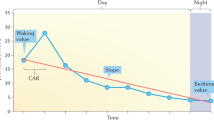Abstract
Aggression is a common management problem for child psychiatry hospital units. We describe an exploratory study with the primary objective of establishing the feasibility of linking salivary concentrations of three hormones (testosterone, dehydroepiandrosterone [DHEA], and cortisol) with aggression. Between May 2011 and November 2011, we recruited 17 psychiatrically hospitalized boys (age 7–9 years). We administered the Brief Rating of Aggression by Children and Adolescents (BRACHA) and Predatory-Affective Aggression Scale (PAAS) upon admission. Saliva samples were collected from the participants during a 24-h period shortly after admission: immediately upon awakening, 30 min later, and again between 3:45 and 7:45 P.M. Nursing staff recorded Overt Aggression Scale ratings twice a day during hospitalization to quantify aggressive behavior. The salivary cortisol concentrations obtained from aggressive boys 30 min after awakening trended higher than levels from the non-aggressive boys (p = 0.06), were correlated with the number of aggressive incidents (p = 0.04), and trended toward correlation with BRACHA scores (p = 0.06). The aggressive boys also showed greater morning-to-evening declines in cortisol levels (p = 0.05). Awakening levels of DHEA and testosterone were correlated with the severity of the nearest aggressive incident (p < 0.05 for both). The BRACHA scores of the aggressive boys were significantly higher than scores of the non-aggressive boys (p < 0.001). Our data demonstrate the feasibility of collecting saliva from children on an inpatient psychiatric unit, affirm the utility of the BRACHA in predicting aggressive behavior, and suggest links between salivary hormones and aggression by children who undergo psychiatric hospitalization.
Similar content being viewed by others
References
Barzman DH, Brackenbury L, Sonnier L, et al.: Brief rating of aggression by children and adolescents (BRACHA): Development of a tool for assessing risk of inpatients’ aggressive behavior. Journal of the American Academy of Psychiatry and the Law 39(2):170–179, 2011.
Vitiello B, Behar D, Hunt J, Stoff D, Ricciuti A: Subtyping aggression in children and adolescents. Journal of Neuropsychiatry and Clinical Neurosciences 2(2):189–192, 1990.
Barzman D, Patel A, Sonnier L, Strawn J: Neuroendocrine aspects of pediatric aggression: Can hormone measures be clinically useful? Neuropsychiatric Disease and Treatment 6:691–697, 2010.
Granger DA, Schwartz EB, Booth A, Arentaz M: Salivary testosterone determination in studies of child health and development. Hormones and Behavior 35(1):18–27, 1999.
Barzman D, Mossman D, Sonnier L, Sorter M: Brief rating of aggression by children and adolescents (BRACHA): A reliability study. Journal of the American Academy of Psychiatry and the Law 40:374–382, 2012.
Yudofsky SC, Silver JM, Jackson W, Endicott J, Williams D: The overt aggression scale for the objective rating of verbal and physical aggression. American Journal of Psychiatry 143:35–39. 1986.
Kafantaris V, Lee DO, Magee H, et al.: Assessment of children with the overt aggression scale. Journal of Neuropsychiatry and Clinical Neurosciences 8:186–193, 1996.
Cueva JE, Overall JE, Small AM, et al.: Carbamazepine in aggressive children with conduct disorder: A double-blind and placebo-controlled study. Journal of the American Academy of Child and Adolescent Psychiatry 35:480–490, 1996.
Malone RP, Delaney MA, Luebbert JF, et al.: A double-blind placebo-controlled study of lithium in hospitalized aggressive children and adolescents with conduct disorder. Archives of General Psychiatry 57:649–654, 2000.
Dura Trave T, Juste Ruiz M, Gonzalez Montero R, Gutierrez Teren M, Mauri Dot M, Moya Benavent M: Sensitivity of the clonidine and guanfacine tests (alpha-2-adrenergic agonists) as pharmacologic stimulants of growth hormone. Effects on plasma cortisol. Anales Españoles de Pediatría 45:575–578, 1996.
McBurnett K, Lahey BB, Rathouz PJ, Loeber R: Low salivary cortisol and persistent aggression in boys referred for disruptive behavior. Archives of General Psychiatry 57:38–43, 2000.
Van Bokhoven I, Van Goozen SHM, van Engeland H, Schaal B, Arseneault L, Séguin JR, Nagin DS, Vitaro F, Tremblay RE: Salivary cortisol and aggression in a population-based longitudinal study of adolescent males. Journal of Neural Transmission 112:1083–1096, 2005.
Shoal GD, Giancola PR, Kirillova GP: Salivary cortisol, personality, and aggressive behavior in adolescent boys: A 5-year longitudinal study. Journal of the American Academy of Child and Adolescent Psychiatry 42:1101–1107, 2003.
Acknowledgments
The project described was supported in part (Mr. Blom) by the National Center for Research Resources and the National Center for Advancing Translational Sciences, National Institutes of Health, through Grant 8 UL1 TR000077-04. The content is solely the responsibility of the authors and does not necessarily represent the official views of the NIH. This project was in part supported by NIMH P50 MH077138. The authors gratefully acknowledge funding support from the American Academy of Psychiatry and the Law’s Institute for Education and Research.
Conflict of interest
Jeffrey Strawn declares he has received research support from Eli Lilly, Shire, American Academy of Child & Adolescent Psychiatry and honoraria from the American Academy of Child & Adolescent Psychiatry. Drew Barzman declares he has research support either recently or currently from NIMH, Oxley Foundation, Cincinnati Children’s Hospital Medical Center, American Academy of Psychiatry and the Law Institute for Education and Research, and the Center for Clinical and Translational Science and Training (CCTST) (University of Cincinnati Academic Health Center). Bianca Patel declares that she has received funding from the American Physician Institute in association with CMEtoGO. Dr. Geracioti receives research funding from the U.S. Department of Defense and is a shareholder in RxDino, LLC. Melissa DelBello declares that she has received research support from AstraZeneca, Eli Lilly, Johnson & Johnson, Janssen, Pfizer, Otsuka, Sumitomo, NIDA, NIMH, NIAAA, NARSAD, GlaxoSmithKline, Merck, Novartis, and Lundbeck. She is on the lecture bureau of Bristol-Myers Squibb, Merck, and Otsuka. Dr. DelBello declares that she has consulted, been on the advisory board, and/or has received honoraria from Merck, Schering-Plough, and Pfizer. The other authors declare that they have no conflicts of interest.
Author information
Authors and Affiliations
Corresponding author
Rights and permissions
About this article
Cite this article
Barzman, D.H., Mossman, D., Appel, K. et al. The Association Between Salivary Hormone Levels and Children’s Inpatient Aggression: A Pilot Study. Psychiatr Q 84, 475–484 (2013). https://doi.org/10.1007/s11126-013-9260-8
Published:
Issue Date:
DOI: https://doi.org/10.1007/s11126-013-9260-8



